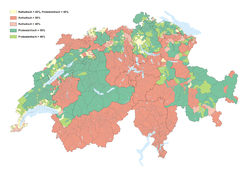Swiss Reformed Church

The Swiss Reformed Church (German: Evangelisch-reformierte Kirchen der Schweiz, "Evangelical-Reformed Swiss Church") refers to the Reformed branch of Protestantism in Switzerland started in Zürich by Huldrych Zwingli and spread within a few years to Basel (Johannes Oecolampadius), Bern (Berchtold Haller and Niklaus Manuel), St. Gallen (Joachim Vadian), to cities in southern Germany and via Alsace (Martin Bucer) to France.
Since 1920, the Swiss Reformed Churches have been organized in 26 member churches of the Federation of Swiss Protestant Churches. According to a 2012 Swiss census, 26.9% of Swiss population were reported as registered members of a Reformed cantonal church.
History
The Reformation spread primarily in the cities of Switzerland, which was then composed of loosely connected cantons. Breakthrough began in the 1520s in Zurich under Zwingli, in Bern in 1528 under Berchtold Haller, in Basel in 1529 under John Oekolampad. After the early death of Zwingli in 1531, the Reformation continued. The French-speaking cities Neuchâtel, Geneva and Lausanne changed to the Reformation ten years later under William Farel and John Calvin coming from France. The Zwingli and Calvin branches had each their theological distinctions, but in 1549 under the lead of Bullinger and Calvin they came to a common agreement in the Consensus Tigurinus (Zürich Consent), and 1566 in the Second Helvetic Confession. The German Reformed ideological center was Zurich, the French speaking Reformed movement bastion was Geneva.
A distinctive feature of the Swiss Reformed churches in the Zwinglian tradition is their historically almost symbiotic link to the state (cantons), which is only loosening gradually in the present. In cities where the Reformed faith became leading theology, several confessions were written, some of them:
- The 67 Articles of Zurich
- Theses of Berne 1528
- Berne Synodus 1532
- Confession of Geneva 1537
- Second Helvetic Confession written by Bullinger in 1566
In the mid 19th century, opposition to liberal theology and interventions by the state led to secessions in several cantonal churches. One of these secessionist churches still exists today, the Geneva Free Church, founded in 1849.[1] An important issue to liberal theologians was the Apostles' Creed. They questioned its binding character. This caused a heated debate. Until the late 1870s, most cantonal reformed churches stopped prescribing any particular creed.[2]
In 1920 the Federation of Swiss Protestant Churches (Schweizerischer Evangelischer Kirchenbund, Fédération des Eglises protestantes de Suisse, Federazione delle Chiese evangeliche della Svizzera - SEK-FEPS), with 24 member churches — 22 cantonal churches and 2 free churches (Free Church of Geneva and the Evangelical-Methodist Church of Switzerland), was formed to serve as a legal umbrella before the federal government and represent the church in international relations.
Organization and membership
Organizationally, the Reformed Churches in Switzerland remain separate, cantonal units. The German churches are more in the Zwinglian tradition; the French more in the Calvinist tradition. They are governed synodically and their relation to the respective canton (in Switzerland, there are no church-state regulations at a national level) ranges from independent to close collaboration, depending on historical developments.
Reformed Churches in the Swiss cantons:

- Reformed Church of Aargau
- Evangelical-Reformed Church of Appenzell
- Evangelical Reformed Church of the Canton Basel-Landschaft
- Evangelical-Reformed Church of the Canton Basel-Stadt
- Reformed Churches of the Canton Bern-Jura-Solothurn
- Evangelical Reformed Church of the Canton Freiburg
- Protestant Church of Geneva
- Evangelical Free Church of Geneva
- Evangelical Reformed Church of the Canton of Glarus
- Evangelical Reformed Church of Graubünden
- Evangelical Reformed Church of the Canton of Lucerne
- Reformed Church of the Canton of Neuchâtel
- Evangelical-Reformed Church of Nidwalen
- Association of Evangelical Reformed Churches in the Canton of Obwalden
- Evangelical Reformed Church of the Canton of St. Gallen
- Evangelical Reformed Church of the Canton of Schaffhausen
- Evangelical Reformed Church of the Canton of Schwyz
- Evangelical Reformed Church of the Canton of Solothurn
- Evangelical Reformed Church of Ticino
- Evangelical Church of the Canton of Thurgau
- Evangelical Reformed Church of Uri
- Evangelical Reformed Church of the Canton of Vaud
- Evangelical Reformed Church in Valais
- Evangelical Reformed Church of the Canton of Zürich
- Evangelical Reformed Church of the Canton of Zug[3]
References
- ↑ "Overview of Switzerland". Reformed Online.
- ↑ Rudolf Gebhard: Apostolikumsstreit in German, French and Italian in the online Historical Dictionary of Switzerland, 2011-01-27.
- ↑ www.reformiert-online.net/weltweit/land.php?id=131&lg=eng